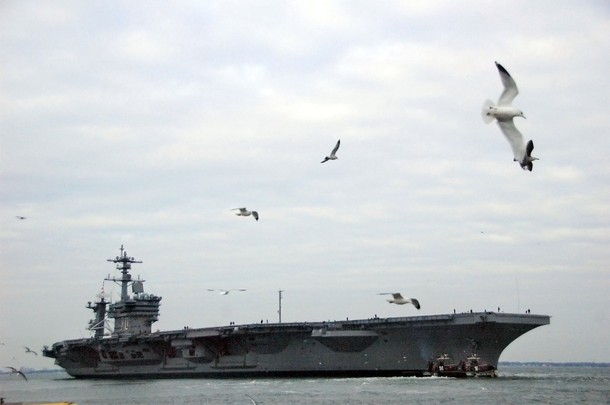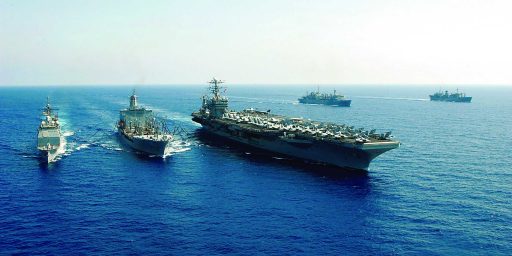Dual Purpose

In this handout image provided by the U.S. Navy, the Nimitz-class aircraft carrier USS Carl Vinson (CVN 70) departs Naval Station Norfolk January 12, 2010 off the coast of Norfolk, Virginia. Carl Vinson is underway following a four-year refueling and complex overhaul to take part in Southern Seas 2010. After completing Southern Seas, Carl Vinson will change homeport from Norfolk, Va. to San Diego, Calif. (Photo by Petty Officer 2nd Class Rafael Martie/U.S. Navy via Getty Images)
As the world mobilizes support for earthquake-stricken Haiti, aid organizations are running into some snags:
Amid looting of United Nations and other food stocks in Haiti, international relief agencies struggled Friday to find alternative routes for aid in the face of survivors’ angry criticism that no help was getting through, threatening them with a second catastrophe after Tuesday’s earthquake.
With relief flights snarled at Port-au-Prince airport, officials at international aid organizations in Geneva and Rome said in telephone interviews that the likely alternatives included a land-and-air bridge between Port-au-Prince and Santo Domingo in the neighboring Dominican Republic and the deployment of roll-on, roll-off vessels capable of unloading supplies at the badly damaged port in the Haitian capital.
Much of Haiti’s civil infrastructure, fragile to start out with, has been damaged by the earthquake. Aid workers on site at the time of the quake are themselves its victims. Aid workers attempting to get in are running into obstacles presented by the lack of functioning transport systems. Regardless of the need The Haitian government has stopped accepting flights:
The Haitian government stopped accepting flights Thursday because ramp space at the airport was saturated and no fuel was available, said Federal Aviation Administration spokeswoman Laura Brown.
There’s only one institution in the world that is capable on short notice of bringing an airport, a water purification plant, a major hospital, and workers complete with the facilities to support themselves to the site. The institution is the U. S. Navy and the name of the airport and water purification plant is the USS Carl Vinson:
USS CARL VINSON, At sea (NNS) — The Nimitz-class aircraft carrier USS Carl Vinson (CVN 70) arrived off the coast of Port-Au-Prince, Haiti Jan. 15 to commence humanitarian assistance and disaster relief operations.
Carl Vinson received orders from U.S. Southern Command to deliver assistance to the Caribbean nation following a 7.3 magnitude earthquake which caused catastrophic damage within the capital city Jan. 12. The aircraft carrier’s speed, flexibility and sustainability make it an ideal platform to carry out relief operations.
“Our initial focus is to concentrate on saving lives while providing first responder support to the people of Haiti. Our assistance here reflects our nation’s compassion and commitment to those impacted by this tragedy,” said Rear. Adm. Ted Branch, commander of the Carl Vinson Carrier Strike Group and the U.S. Navy’s sea-based humanitarian support mission of Haiti.
The carrier arrived on station with a robust airlift capability, picking up extra helicopters while in transit that will will prove essential during the mission.
The name of the hospital is the USNS Comfort.
Within hours of the earthquake a Coast Guard C-130 had already landed in Port-au-Prince, bringing the equipment to set up field hospitals and communications centers. Four large Coast Guard ships are already in Haiti.
This is not an isolated instance. Following the Indonesian tsunami in 2004 American aircraft carriers were among the earliest to arrive on the scene. In the aftermath of the earthquake in Pakistan in 2005 the U. S. Navy became the largest healthcare provider in the country for more than a year.
The ability to project force also gives us the ability to project aid. Europe’s wealthy nations in eschewing the ability to project force have not substituted a commensurate capability of projecting aid.
I have been consistently critical of our large military expenditures and I remain so. It is simply unconscionable that we spend so much on our military. However, the reason that we spend nearly as much as the rest of the world combined may be that our European allies aren’t spending enough.
I will continue to be critical of our large military expenditures but in circumstances like these I can only say thank God for the U. S. Navy. And thank God for the Coast Guard.






Amen.
Mr. Schuler. Your comment is sensible. Most people can accept large expenditures when you agree with the reason.
Indeed. I’ve often suggested — half-jokingly — that one of the best investments we could make as a nation would be to give an old carrier to USAID. Take the jets off, put on additional helicopters, and you have are incredible humanitarian assistance capability that would pay real dividends in terms of America’s global image.
I knew a girl who was a reserve nurse, back in peacetime. She told me that on weekends (not sure how often) they would pack up the C130 and practice flying to disasters. They’d actually fly across the country. Practice makes perfect, but practicing with C130s can’t be cheap.
Excellent post.
Well, if it wasn’t being used for the military, and if it was idle for even a little while between catastrophes, *somebody* would consider it a waste of money and cut off funding. Only if it was for our glorious military would it be considered off limits to funding cuts!
In addition of naval units, the 22d MEU is being sent:
From the TV pictures I’m seeing, those are USAF C-17s on the tarmac at Port au Prince, and the people unloading the pallets of relief supplies are USAF ground personnel. And it’s the USAF who flew in the 82nd Airborne personnel. It’s a team effort, and no one service should claim primacy of the credit for this effort.
Sorry Bernard, but holding a carrier simply for humanitarian aid would cost hundreds of thousands of dollars every day just to have it at the dock, ready to go. Once it was called into service quadruple that cost. Oh and all our carriers are nukes, multiply the costs by 10 or 100.
Add to the equation the fact that US military responders have the training and capability to keep the resources from being stolen and ensure it gets to those in need.
Large ships ready to go on a moments notice are only “cost effective” if they are multi-mission. The US Navy and USCG are able to deploy military capability or humanitarian aid capability as required by the situation on the ground.
I’d be interested in seeing a reasonable estimate of this cost. My hunch is that much of the cost of a carrier is sunk cost, and holding one at the dock on maintenance power and the barest of skeleton crews might not be particularly expensive.
The largest looming issue is the logistics. For the quantities needed sea transport is the most viable option, but the port has substantial issues. The road from Santo Domingo (~200 miles) isn’t much and there are reports of no fuel. Galrahn at the Naval blog Information Dissemination has an excellent lengthy post on the challenges and way ahead.
Another problem might be all the NGOs and news organizations that will show up and get in the way of relief efforts as they address their niche. There will be hundreds, if not thousands of organizations showing up.
Just heard an interview with an OxFam representative in Haiti on the BBC. Apparently, the NGO’s are having a major problem coordinating their activities because there’s no or limited cell phone service or Internet connectivity.
There are many issue to be solve including opening more pipelines. A little ingenuity needs to be used. Using small and medium size ships with their own cranes and opening other airstrips\beachheads are good starters. Security for the relief effort will become a major concern.
However the biggest problem I can see happening in good old bureaucracy. There will be a natural impulse to centralized control and supplies and the “need†for more information. All of which has some legitimacy but if they are not careful, it will result in great impediment of action.
This.
Would you criticize the US Government if a disaster like this happened in our backyard, as it has, and we didn’t have the means to help? mpw
Thank you JKB for confirming what I said above your post. It’s only money well-spent for a war machine, not for doing some good in this world.
P.S. Why would a humanitarian carrier need nukes?
Just to clarify: He wasnt’ saying they had nukes on board, but that they are ran by nuclear power. They aren’t diesel carriers (or whatever fuel they use as an alternative to nuclear on massive ships). Maintaining a nuclear reactor is, from my limited understanding, quite expensive.
Still, I’d count using tax money to fund a nuclear generator used to bring peace and relief to devasted countries a good use of taxes. I could think of far worse uses that are in place now.
Bunker fuel is what they tend to use on the massive ships..